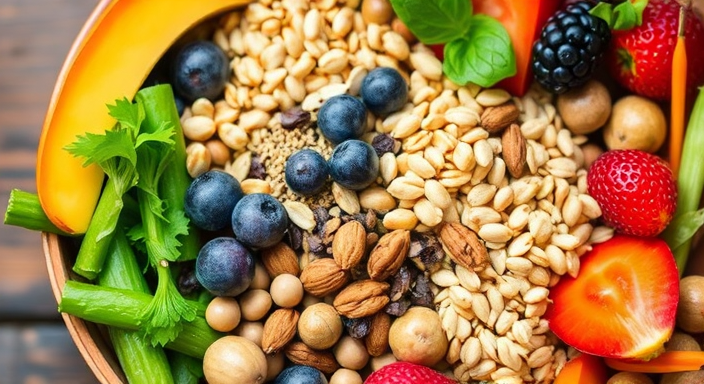In a world saturated with diet fads, restrictive eating plans, and constant messaging about what we should and shouldn’t eat, it’s easy to lose touch with our body’s natural wisdom. We’re bombarded with external rules and guidelines, often ignoring the very cues our bodies are constantly sending us. But what if there was a different approach? What if we could learn to trust our bodies again and cultivate a relationship with food that is based on respect, nourishment, and joy?

This is where mindful and intuitive eating Mindful and Intuitive Eating comes in. These are not diets, but rather philosophies and practices designed to help you reconnect with your inner wisdom and build a healthier, more sustainable relationship with food and your body. Let’s dive in and explore how you can unlock this inner wisdom and embark on a journey toward food freedom through intuitive and mindful eating.
Table of Contents
What is Mindful Eating?
Mindful eating is about bringing awareness to your eating experience, paying attention to your physical hunger cues, the taste and texture of your food, and the overall sensory experience of eating. It’s about being present in the moment and letting go of distractions and judgments. This concept is vital for understanding the basics of mindful and intuitive eating.

Think about the last time you ate a meal in front of the television. Were you truly savoring each bite? Were you even aware of how quickly you were eating or how full you were becoming? Chances are, your attention was divided, and you missed out on a significant part of the experience. This is where mindful eating practices come in.
Key components of mindful eating include:
- Paying Attention to Physical Hunger Cues: Recognizing the difference between physical hunger (your body needing fuel) and emotional hunger (eating in response to feelings). This is a building block for achieving successful mindful and intuitive eating.
- Eating Without Distractions: Turning off the TV, putting away your phone, and creating a calm eating environment.
- Chewing Thoroughly: Taking the time to chew your food properly, allowing you to savor the flavors and aiding in digestion.
- Savoring Each Bite: Paying attention to the taste, texture, and aroma of your food.
- Paying Attention to Your Body’s Signals of Fullness: Recognizing when you’re comfortably satisfied, not overly full.
- Observing Thoughts and Feelings: Noticing any thoughts or feelings that arise during the eating experience, without judgment.
By practicing mindful eating techniques, you can become more attuned to your body’s needs, enjoy your food more fully, and ultimately make more conscious choices about what and how you eat.
What is Intuitive Eating?
Intuitive eating takes the principles of mindful eating a step further. It’s a self-care eating framework that emphasizes listening to your body’s internal cues of hunger, fullness, and satisfaction to guide your food choices. It rejects restrictive dieting and promotes body trust. Many people turn to mindful and intuitive eating as a way to heal their relationship with food and their bodies.

Developed by registered dietitians Evelyn Tribole and Elyse Resch, intuitive eating is based on 10 core principles:
- Reject the Diet Mentality: Recognize that diets are often ineffective in the long run and can actually harm your relationship with food.
- Honor Your Hunger: Feed your body when you’re physically hungry, allowing yourself to eat enough to satisfy your needs.
- Make Peace with Food: Give yourself unconditional permission to eat all foods, without guilt or shame.
- Challenge the Food Police: Question the negative thoughts and beliefs about “good” and “bad” foods.
- Discover the Satisfaction Factor: Find pleasure and enjoyment in your food, enhancing your overall eating experience.
- Feel Your Fullness: Pay attention to your body’s signals of fullness and stop eating when you’re comfortably satisfied.
- Cope with Your Emotions with Kindness: Find healthy ways to manage your emotions without turning to food. This principle is especially important for those exploring mindful and intuitive eating.
- Respect Your Body: Accept and appreciate your body for what it is, regardless of its size or shape.
- Movement – Feel the Difference: Focus on moving your body in ways that feel good, rather than for the sole purpose of burning calories.
- Honor Your Health – Gentle Nutrition: Make food choices that support your overall health and well-being.
Debunking Common Misconceptions about Intuitive Eating:
It’s important to address some common misconceptions surrounding intuitive eating:
- “It’s just about eating whatever you want.” While intuitive eating allows for flexibility and enjoyment of all foods, it’s not about eating impulsively or without regard for your health. It’s about making conscious choices based on your body’s needs and desires.
- “It’s a diet in disguise.” Intuitive eating is explicitly anti-diet. It’s not about restricting calories or following rigid rules. It’s about developing a sustainable and enjoyable way of eating that supports your well-being.
- “It’s only for people who are already at a healthy weight.” Intuitive eating can be beneficial for people of all shapes and sizes. It can help you improve your relationship with food, regardless of your current weight.
Mindful Eating vs. Intuitive Eating: Key Differences and Overlaps
While both mindful and intuitive eating are valuable approaches to developing a healthier relationship with food, there are some key differences and overlaps.
Think of mindful eating as a tool that supports intuitive eating. Mindful eating provides the foundation of awareness and presence that allows you to better connect with your body’s internal cues.
- Mindful eating focuses on the how of eating, while intuitive eating focuses on the why and what of eating. Mindful eating is about the process of eating itself – paying attention to the sensations, flavors, and textures of your food. Intuitive eating is about understanding why you’re eating (hunger, satisfaction, or emotions) and what foods your body needs to thrive.
- Mindful eating is a component of intuitive eating. It is the practice that allows you to tune into your body and recognize hunger, fullness, and satisfaction cues. Without mindfulness, it’s difficult to practice intuitive eating effectively.
- Both approaches promote body trust and reject restrictive dieting. They both encourage you to trust your body’s wisdom and reject the harmful cycle of dieting and restriction. Those seeking freedom from dieting often find solace in mindful and intuitive eating.
Ultimately, both mindful and intuitive eating are about cultivating a more positive and sustainable relationship with food.
Benefits of Mindful and Intuitive Eating:
The benefits of adopting a mindful and intuitive approach to eating are numerous and far-reaching:

- Improved Relationship with Food (Reduced Guilt and Shame): By giving yourself permission to eat all foods and challenging negative food beliefs, you can reduce feelings of guilt and shame associated with eating. Learning how to eat intuitively is a pathway to food freedom.
- Enhanced Body Awareness: You become more attuned to your body’s hunger, fullness, and satisfaction cues, leading to more conscious and informed food choices.
- Reduced Emotional Eating: By learning to cope with emotions in healthy ways, you can reduce the tendency to turn to food for comfort or distraction.
- Potential for Sustainable Weight Management (Through Improved Hunger and Satiety Cues): While not the primary goal, intuitive eating can lead to more sustainable weight management by helping you eat in alignment with your body’s needs. When you are eating when truly hungry and stopping when full, your body naturally regulates.
- Increased Overall Well-being and Satisfaction: By enjoying your food and trusting your body, you can experience greater satisfaction and overall well-being. No longer feeling the burden of diet rules or body image concerns frees up mental and emotional space. Individuals who adopt mindful and intuitive eating report significant improvements in their mental and physical health.
Getting Started: Practical Tips for Beginners
Ready to embark on your journey toward mindful and intuitive eating? Here are some practical tips to get you started:

- Start Small: Don’t try to change everything overnight. Choose one or two simple practices to incorporate into your daily routine. For example, try having one mindful meal a day or checking in with your hunger levels before you eat.
- Create a Calm Eating Environment: Minimize distractions by turning off the TV, putting away your phone, and finding a quiet place to eat.
- Practice Gratitude: Before you begin eating, take a moment to appreciate your food. Consider where it came from and the effort that went into preparing it.
- Tune into Your Body: Pay attention to physical hunger and fullness cues. Ask yourself, “Am I truly hungry?” and “Am I comfortably satisfied?”
- Be Patient and Kind to Yourself: This is a journey, not a destination. There will be setbacks and challenges along the way. Be patient with yourself and remember that progress takes time.
- Challenge Food Rules: Question your beliefs about “good” and “bad” foods. Are these beliefs based on sound evidence, or are they simply ingrained from diet culture?
- Focus on Nourishment, Not Deprivation: Instead of focusing on what you can’t eat, focus on nourishing your body with foods that make you feel good, both physically and emotionally.
Here’s a Simple Mindful Eating Exercise to Try Right Now:
- Choose a small piece of food (e.g., a raisin, a piece of chocolate, a nut).
- Hold it in your hand and observe it closely. Notice its color, shape, texture, and aroma.
- Bring it to your nose and inhale deeply. What scents do you notice?
- Place the food in your mouth, but don’t chew. Let it sit on your tongue and experience its flavor and texture.
- Slowly begin to chew, paying attention to the sensations in your mouth.
- Continue chewing until the food is completely broken down.
- Swallow the food and notice how it feels as it travels down your throat.
- Take a moment to reflect on the experience. What did you notice? How did it make you feel?
This simple exercise can help you cultivate a greater sense of awareness and presence during your eating experience, a crucial step in practicing mindful and intuitive eating.
When to Seek Professional Help:
While mindful and intuitive eating can be empowering, it’s important to recognize when professional help is needed. If you have a history of disordered eating, struggle with body image issues, or find it difficult to trust your body’s cues, seeking guidance from a registered dietitian or therapist specializing in intuitive eating is highly recommended. These professionals can provide personalized support and help you navigate the challenges of developing a healthier relationship with food.
Conclusion: mindful and intuitive eating
Mindful and intuitive eating offer a powerful alternative to the restrictive and often harmful world of dieting. By learning to listen to your body’s internal wisdom, you can cultivate a more positive and sustainable relationship with food, reduce emotional eating, and enhance your overall well-being.

It’s time to reject the diet mentality, embrace body trust, and unlock your inner wisdom. Experiment with the tips provided, be patient with yourself, and discover what works best for you.
Start your journey to food freedom today! You deserve to nourish your body and mind with joy, respect, and self-compassion. The key to a healthier, happier you lies within. Listen to your body, trust your intuition, and savor every moment along the way. Mindful and intuitive eating are not just about food; they’re about life.
FAQs for Mindful and Intuitive Eating
What exactly is Mindful and Intuitive Eating? Is it a diet?
- Why it’s trending: This addresses the fundamental question and tackles the common misconception that it’s a diet.
2. How are Mindful Eating and Intuitive Eating different? What do they have in common?
- Why it’s trending: Clarifies the nuances between the two approaches and highlights their shared goals.
3. Can Mindful and Intuitive Eating help me lose weight?
- Why it’s trending: This addresses a very common concern, even though these approaches are not weight-loss focused. It’s important to answer honestly and redirect to the focus on health and well-being.
4. Is Intuitive Eating just about eating whatever I want, whenever I want?
- Why it’s trending: Debunks a significant misconception that it’s a free-for-all.
5. How do I start practicing Mindful Eating? What are some easy exercises?
- Why it’s trending: Provides practical steps for beginners, making the concept more accessible.
6. What are the 10 principles of Intuitive Eating?
- Why it’s trending: This is directly related to the core methodology of intuitive eating.
7. What if I can’t tell the difference between physical hunger and emotional hunger?
- Why it’s trending: Addresses a common challenge and suggests strategies for distinguishing the two.
8. Is Mindful and Intuitive Eating suitable for people with a history of disordered eating?
- Why it’s trending: Raises a crucial safety concern and emphasizes the importance of professional guidance.
9. How long does it take to become an Intuitive Eater?
- Why it’s trending: Sets realistic expectations and emphasizes that it’s a process.
10. Can I still eat “unhealthy” foods while practicing Intuitive Eating?
- Why it’s trending: Addresses the fear of restriction and the concept of unconditional permission.
11. How do I cope with social situations where unhealthy food choices are prevalent while staying true to Intuitive Eating?
- Why it’s trending: Addresses the practical challenges of navigating social events.
12. How can I teach my children to practice Mindful and Intuitive Eating?
- Why it’s trending: Reflects a growing interest in raising children with a healthy relationship with food.
13. I’ve tried dieting for years, and it hasn’t worked. Can Mindful and Intuitive Eating really help me?
- Why it’s trending: Speaks to the frustration of chronic dieters and offers a different approach.
14. How do I honor my cravings without feeling guilty or out of control?
- Why it’s trending: Addresses the fear of cravings and offers strategies for managing them mindfully.
15. Are there any resources or books you recommend for learning more about Mindful and Intuitive Eating?
- Why it’s trending: People are actively looking for guidance and reliable information.

Hello! I just would like to offer you a big thumbs up for your excellent info you have got right here on this post.
I am returning to your website for more soon.
Pretty nice post. I just stumbled upon your weblog and wanted to say that I’ve truly
enjoyed surfing around your blog posts. After all I’ll be subscribing to your feed and I hope you write again very soon!